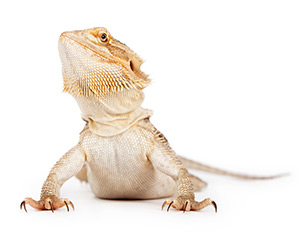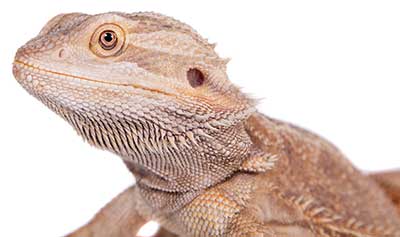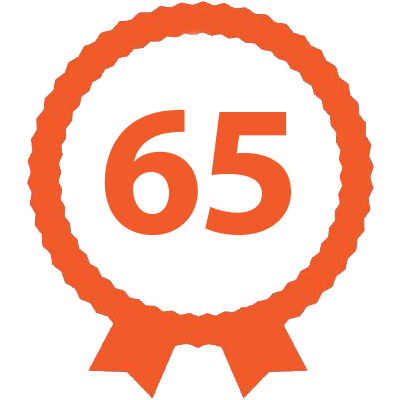Keeping Dragon Species

Bearded & Central Netted Dragons are one of the most popular pets for reptile lovers.
Quick Facts
- With the right care dragons can live for up to 10 years
- UV lighting and heating is necessary
- A varied diet is required (fruit, vegetables and live prey)
- Native to western Queensland and northern South Australia
- Central Bearded Dragons can grow up to 50cm long, whilst Dwarf Bearded Dragons grow to only 35cm. Central Netted Dragons are the smallest at around 25cm long but also live the shortest lives – averaging between 4 – 6 years.
- Dragons can usually be sexed from around 7 months of age or 15cm in length
Adopting a Pet Dragon

Species you can find at Pet City are:
- Dwarf Bearded Dragon (Pogona henrylawsoni),
- Central Netted Dragon (Ctenophorus nuchalis)
- Central Bearded Dragon (Pogona vitticeps)
What you'll need:
Enclosures
Central Bearded Dragons require a larger enclosure than their dwarf cousins; a 4’ long (120cm) enclosure that has space to climb and hide is sufficient for one adult dragon; if you wish to house multiple adults together you will need a larger space. Although Central Bearded Dragons aren’t strictly arboreal, they certainly seem to enjoy climbing and it enriches their environment – as well as keeping their nails trimmed.
Dwarf Bearded Dragons do well in a 3’ (90cm) enclosure. As with Centrals, climbing is beneficial.
NOTE: When housing dragons together it is necessary to ensure that you do not have two males. Regardless of species it is possible that they will fight and they are capable of inflicting serious injuries on each other. Two females housed together can work well. Be careful if you decide to house a male and a female together: they will breed.
Heating and Lighting
These Dragons are native to hot, dry parts of Australia and as a result, they love the sun. A basking spot of between 35 – 42°C aids with their digestion. Setting your thermostat (Microclimate B1 Dimming thermostats are the best to use) to 34°C will give you a good basking temperature; ask our friendly staff about correct thermostat placement.
Using a ‘daylight’ bulb will help to simulate the sun and helps to keep your dragon active and stimulated.(URS Daylight Basking, Trixie Neodymium and Zoomed ReptiSun globes are recommended).
To replicate the amount of ultraviolet light they receive from the sun in the wild, you will need to use a 10% UV fluorescent tube. It is better if you can have one tube that runs the length of your tank; this way the dragon has maximum exposure whilst being in the tank.
NOTE: For the dragon to be able to metabolise the UV light from the bulb, the dragon must be able to climb or sit within 6 inches (approximately 15 – 20cm) of the bulb itself.
NOTE: UV lights MUST be replaced every 6 months; the amount of UV that the bulb creates diminishes from the time it is switched on and after 6 months the amount that the dragon receives is negligible.
Feeding
.jpg)
Regular fruits and veggies: Bok Choi, Squash, Tomato, Carrot, Dandelion flowers, Clover flowers, Apple, Beans, Broccoli, Sweet Potato, Peas, Corn, Celery, Strawberries and Blueberries. It is important to remember not to feed any seeds to your dragon as they can damage the gut.
Treats: Cooked egg, Meal worms, Pinkie mice and lean minced meat. Treats like cooked egg and meal worms are okay to feed to dragons less than 1.5 years of age, however items like pinkie mice and mince should only be fed to breeding females or as a very rare treat (once a month).
Live foods: Crickets, Woodies, Earthworms and Snails. Live foods should not be eaten immediately and not be left to roam the enclosure. Crickets and woodies can feed on the faecal matter in the enclosure before your dragon eats it. This can cause your dragon to become ill.
Dragons <1 year old:
Diet should consist of between 60 – 70% live food, with fruit and veggies comprising the remaining 30 – 40%. Feed live food and fruit and vegetables daily.
Dragons 1 – 2 years old:
Diet should be approximately 50% live food and 50% fruit and veggies. Alternate between feeding live food and fruit and veggies on different days.
Dragons 2 years +:
Diet should be 80% fruit and veggies and 20% live food. Feed every 2 days, live food only twice a week.
NOTE: Feeding young dragons a lot of protein in necessary as they are growing the fastest; older dragons are not growing as fast and so the extra protein in their diet is stored as fat. Excess fat can lead to fatty liver disease and can decrease the lifespan of your pet.
IMPORTANT: Dragons need calcium supplements. Calcium supplements work with UVB to ensure your dragon can synthesise the calcium. This will prevent Metabolic bone disease. Calcium supplementation for reptiles generally dusted over the live food portion of the diet. CalStron and Wombaroo Reptile supplement are highly recommended as dietary supplements for your dragon.
Dragons water dish should be shallow and be big enough for the dragon to fit into.
Young Dragons (in particular henrylawsoni) should be lightly sprayed with water at least once a day to prevent dehydration and promote drinking.
Handling
Dragons can become extremely tame with time; the best way to tame your new best friend is to slowly introduce them to handling. Start by holding them for a couple of minutes every few days; the best way is to gently slide your hand underneath them and then pick them up.
Do not approach your dragon from above and do not pick them up by the tail: this is what predators in the wild do and it will stress your dragon.
Breeding
Given the right diet, dragons can grow to sexual maturity in 1 year. If you keep a male with one or more females, be prepared for eggs!

Female bearded dragons can lay up to 4 clutches each season, with each clutch containing between 5 and 25 eggs.
Housing young dragons can be difficult as they can attack and maim each other. Finding homes for young dragons is not always easy.








